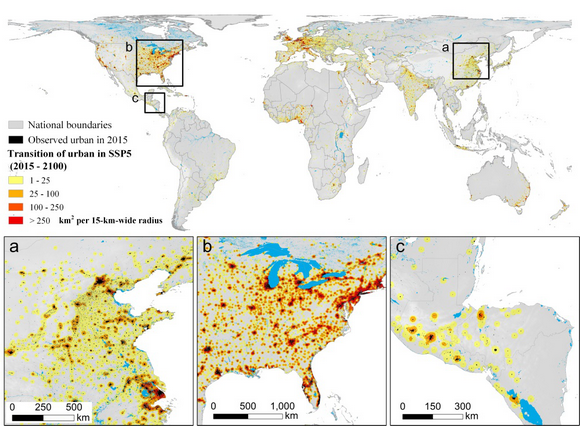Prof. Xiaoping Liu's Group from the School of Geography and Planning published the latest research of global projections of urban land expansion in Nature Communications
Source: School of Geography and Planning
Written by: School of Geography and Planning
Edited by: Xu Jia, Wang Dongmei
On January 27th, the group of Prof. Xiaoping Liu from the School of Geography and Planning of Sun Yat-sen University published a research paper (Article) entitled "Global Projections of Future Urban Land Expansion under Shared Socioeconomic Pathways" in Nature Communications, cooperating with the group of Prof. Xia Li of East China Normal University. Based on the latest Shared Socioeconomic Pathways (SSPs) of the Intergovernmental Panel on Climate Change (IPCC), this study projects the global urban land expansion from 2015 to 2100 with a 1-km resolution and analyzes its impact on food production and natural vegetation.
Urban land covers only a small proportion of the global terrestrial surface, but the existing research shows that urban land and its expansion may have a profound impact on the global environment. Projecting the spatial pattern of urban land requires appropriate scenarios that can represent future socio-economic and environmental conditions. At present, many existing products of global urban land projection use single or customized scenarios, which lead to the failure of unified and comparable research between products. Besides, the spatial resolutions of most of the existing products are rough, mostly 10-50km resolution, leading to the loss of urban land spatial details and failure of reflecting the change of urban spatial pattern. Therefore, the group uses the land-use change model, FLUS, which proposed by Prof. Xiaoping Liu to predict the future global urban land expansion with a 1-km resolution, based on the latest SSP scenarios proposed by IPCC (Figure 1). The results show that countries with different levels of development have different responses to the scenarios, even on the contrary. Some scenarios that are conducive to urban development in developed countries (such as SSP5) are detrimental to urban development in low-income countries. Furthermore, the group analyzes the pressure of urban shrinkage caused by population decline in some areas in some scenarios.

Figure 1 The simulated urban land maps in 2100 for global and representative regions in scenario SSP5. (a) Eastern China, (b) Eastern USA, (c) Low-income countries in Latin America
The study also analyzed the loss of food production due to future urban land expansion. Approximately 50–63% of the newly expanded urban land is expected to occur on current croplands. Without considering the possibility of compensating for the expected food loss through the improvements in agricultural management, global crop production will decline by approximately 1–4%. These crop production losses will affect the annual needs for a certain food of ~122–1389 million people if these losses cannot be compensated with the productions of other food crops. The results also show that the disproportion between loss of farmland and loss of food production, which suggests the importance of conserving high-quality croplands to reduce the impacts of urban expansion on food production capacity. Therefore, governance and proper planning of urban land development locations and procedures is a key measure to reduce future losses in crop production.
This study was supported by the National Key R&D Program of China, the Key Program of the National Natural Science Foundation of China, and the General Program of the National Natural Science Foundation of China. Guangzhao Chen, a doctoral student in the School of Geography and Planning of Sun Yat-sen University, is the first author of the paper. Prof. Xia Li of East China Normal University, and Prof. Xiaoping Liu and Associate Professor Yimin Chen of Sun Yat-sen University are the corresponding authors of the paper.
Link to the paper: https://www.nature.com/articles/s41467-020-14386-x
